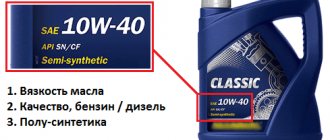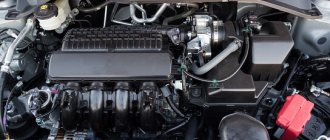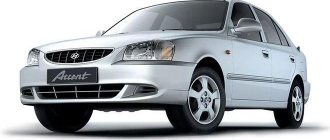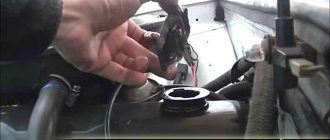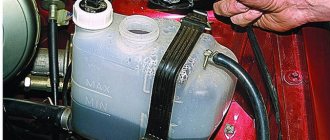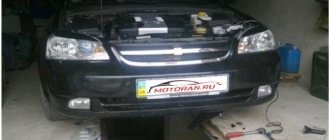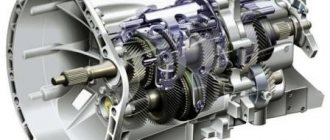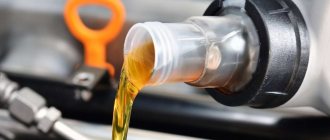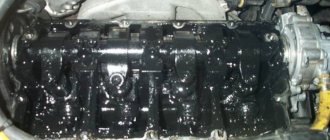Normal engine functionality is ensured by timely oil changes; the Peugeot 308 is no exception in this regard. A high-quality lubricant, updated on time, increases the overall service life of the motor. Responding to the car owner's concerns, the engine operates stably at all speeds and maintains technical power parameters for a long period of operation. Regularly changing the engine oil will ensure the perfect combination of fast-dynamic design and functionality of this model.
Why do you need to change the oil in your car?
All lubricants have a temporary functional life . This is due to the fact that the engine is influenced by high temperature, work intensity, environment, and fuel quality. The function of motor oil is not only to lubricate all components of a car's engine, but it also washes away soot deposits that form due to incomplete combustion of fuel. As a result, the engine oil becomes contaminated and requires replacement.
An important question is when to change the oil in a Peugeot engine.
If we talk about the frequency of oil changes, the recommended interval is 10 thousand kilometers or every year .
Recommended indicators for lubricant replacement
The manufacturer advises changing the oil in the Peugeot 308 engine once a year or every 24,000 km. These tips are based on ideal vehicle operating conditions. But in practice, the established indicators are significantly reduced (sometimes twofold).
Reducing the time required to change engine oil is influenced by:
- poor condition of the road surface;
- operating a car in a big city with frequent traffic jams;
- intense dustiness;
- mountainous terrain with noticeable elevation changes;
- engine operation at high speeds when towing trailers, caravans, and other vehicles;
- low quality of lubricants and combustible materials.
You should also pay attention to the fact that after 50,000 km the Peugeot 308 engine may also require oil changes more often. Therefore, the optimal procedure is to change the lubricant every 10,000 km and at least once a year. This optimized oil change schedule can vary between 1500–2000 km, both in the direction of decreasing mileage and increasing it.
A frequently asked question is what kind of oil to use?
Several types of oil are suitable Peugeot cars semi-synthetic, mineral, synthetic . For the Peugeot 308, synthetic is the most optimal . Recommended motor fluid for the engine of this car
Total Quartz 9000 Future NFC 5w-30 article 183450
Recommendations for selection are usually indicated in the vehicle’s operating manual or on the website.
How much oil to fill (filling volumes)
- Glass washer reservoir – 4.5 l;
- Hydraulic drive of the brake system (clutch release) – filled to the MAX level (brake fluid DOT-3 or DOT-4);
- Automatic transmission – 2 l (ATF LT 71141);
- Manual gearbox – 1.9 l (Gearbox oil classification according to API GL-4, SAE 75W-80);
- Power steering amplifier – DEXRONII / DEXRON III (top up as necessary);
- Cooling system – 6 l (Coolant);
- Engine lubrication system - 4.25 (SAE 0W-20, 0W-30, 5W-30 and 5W-40, quality ACEA A3/B3, A3/B4 or A5/B5 and API SM);
- Fuel tank 60 l.
Spread the love
Now let's look at what tools we need:
- motor oil you are going to fill with a volume of 4.3-4.5 liters;
- original oil filter, catalog number 1109A;
- a set of keys and screwdrivers, namely: an “ 8 ” hex key, a “ 27 ” key with a head;
- O- ring for drain plug, catalog number 0313.38 ;
- a container for draining waste, a bucket or canister with a cut hole with a volume of at least 5 liters;
- latex gloves;
- funnel for pouring liquid into the engine crankcase;
- clean rag or rags.
Power steering (power steering)
Power steering helps you turn the steering wheel along with the wheels, while you spend several times less force than a car without a power steering system.
There are marks on the power steering expansion tank by which you can understand whether the fluid level is currently high or, conversely, low and needs to be added. A quick inspection of the power steering system can solve many problems along the way, so look under the hood once a month.
What should you pay attention to?
- Monitoring the power steering fluid (oil) level and its color in the expansion tank;
- Checking the drive belt for the power steering pump;
- General condition of hoses (inspection for cracks, abrasions and chips);
- Hose connection points.
How to change
Changing the power steering fluid (oil) can be done in several ways, including partially changing the fluid and completely changing it. The first method is faster and easier, the second is better.
Partial replacement
Partial replacement of power steering fluid involves pumping fluid out of the power steering expansion tank using a large syringe or bulb. After the tank is completely empty, fill in fresh fluid to the maximum mark. Start the car and turn the steering wheel left/right. After a few minutes, turn off the engine and check the color of the power steering fluid. If it is too dark, repeat the procedure until the desired result.
Complete replacement
To replace the power steering fluid, remove the air duct and the reservoir with power steering fluid. Pour the old liquid from the barrel into another container. When draining, pay attention to the condition of the old oil and the presence of foreign metal particles. If they are noticeable, this may indicate wear on the pump. To completely drain the power steering, you can rotate the steering wheel left and right.
Step-by-step instruction:
- Warm up the car so that the oil becomes fluid and can be easily drained; to do this, start the car and let it idle for 7-10 minutes.
- After this, place the car on a flat, horizontal surface, for example, in a garage.
- After the engine is turned off, unscrew the filler cap. Remove the engine protection by unscrewing the mounting bolts.
- We are replacing the oil filter, which has a cassette design. To do this, remove the plastic cover, slightly loosen the clamp, gain access to the air intake, and remove it. On the side of the engine there is an old oil filter, which we remove .
- We place a container for draining old engine oil under the hole in the engine crankcase. We unscrew the drain plug and let the oil drain, then screw the plug back in.
- Fill the engine with new oil through the oil filler hole. Fill in 2.5 liters of engine fluid, then add 150 - 200 ml of fluid until it reaches the maximum mark on the dipstick.
- Screw on the neck cap.
- We start the car engine and make sure that light goes out , this will be a signal that you have done all the previous steps correctly.
- We turn off the engine, wait until it cools down, and carry out a control measurement of the oil, if necessary, add it.
Don’t forget to reset the counter, which records the timing of scheduled maintenance.
In order to do this, turn on the ignition and hold the counter button to zero. When zero , release the button.
Basic principles for selecting engine oil
Successful selection of the optimal lubricant for the Peugeot 308 engine helps reduce fuel consumption and increase the power of the power unit. You can give preference to different manufacturers and brands. But it is always advisable to follow the basic principles for selecting motor oil in order to sufficiently justify your option:
- you need to choose only a certified, original, high-quality product;
- do not go beyond the permissible classification limits established by the manufacturer (0W30; 5W30; 5W40);
- when changing the type of oil used, be sure to flush the engine with special substances;
- An increase in engine age leads to an increase in the viscosity of the motor lubricant.
Practical car enthusiasts advise, after draining the old lubricant, to fill in several liters of new one (according to the minimum indicator on the dipstick). Allow the engine to run for approximately 10 minutes. The lubricant is poured into a container and the engine is filled with the same new oil to the required volume.
The refusal to use flushing agents is motivated by the fact that modern lubricants from leading manufacturers contain various components, including detergents. The efficiency of flushing can be increased by driving 1500–2000 km on ordinary high-quality oil, then replacing it with a permanent one.
The answer to the question of what kind of oil to pour into the Peugeot 308 engine depends on the seasons of primary use of the car. For summer, the optimal option is an oil product with a viscosity index of 5W40. In winter, it is better to fill in car oil designated 0W30.
How much oil is needed to change?
Regarding Peugeot 308 vehicles, the most pressing question is how much oil is required to replace it in the engine. Searching for an answer to this question on various forums does not give an exact result; you can come across different numbers, and at the same time, each of the car owners will claim that he is right, based on personal experience in replacing the lubricant.
The fact is that the Peugeot 308 was equipped from the factory with different engine modifications, depending on which the oil volume varies. In order to find out exactly how much oil is required for the engine of your car, you need to look in the documentation for it for the volume of cylinders with which the unit is equipped. According to the manufacturer, Peugeot 308 models with the 1.4 engine version will require 4.25 liters of oil. For a 1.6 internal combustion engine with a 16V, THP 16V and Turbo HDI design, 3.25, 4.25 and 3.75 liters of motor oil will be required to completely replace it. And the 2 Turbo HDI 16V engine will contain exactly five liters and two hundred and fifty grams of lubricant.
When purchasing motor oil, depending on the type of engine of your car, you need to take the volume of products, rounded up to a whole number, for example, if your power unit requires, according to the instructions, 3.25 liters of lubricant, then buy a four-liter canister. Regardless of the modification of the internal combustion engine, the oil level is checked in all models using a dipstick, and lubrication indicators are considered normal when its criteria are midway between the MIN and MAX marks.
Differences between replacing the oil filter in other Peugeot models
Replacing the oil filter on a Peugeot 408 with your own hands is a procedure similar to that on a Peugeot 308. The filtration is installed in it and is not removable - the element cassette can be easily removed and changed. But there are still some peculiarities in the procedure. To get to the cover of the part, you will have to disconnect the air duct pipes. To do this, use a screwdriver to disconnect the resonator clamp and remove it by pressing on the latches. It is not necessary to remove the pipe itself, just loosen it and move it to the side.
In a Peugeot 408, replacing the oil filter also involves removing the pan - this is necessary so that the engine lubricant is completely removed from the system. However, in the Peugeot 308 and the Peugeot 3008, replacing the oil filter is identical. Some Peugeot 3008 models have a crankcase protection installed, which will need to be removed to get to the drain cover.
To independently carry out the procedure for changing the filtration, you do not need to have special knowledge; you just need to follow the technical instructions and recommendations of the manufacturer.
Engine flushing
Do I need to flush the engine before adding new oil?
Without thinking, of course, you can impeccably say that you need to wash, and definitely! It is completely normal that over time, engines will develop sludge, varnish, and other deposits that cause irreparable damage to the engine.
Just remember that not all that glitters is gold.
Try to remember any well-known brands that have similar flushing oils in their arsenal? There are no such. But why? In fact, the answer is very, very simple.
Modern oils have a huge package of additives that act as cleaning agents, such as calcium or sodium. These “agents” do an excellent job of removing sludge and other types of deposits.
As a result, timely oil changes recommended by the car manufacturer will help keep the engine running smoothly and you will never need a flush.
Many car owners use flushing oil when switching from one oil to another, so that the “old” oil goes away along with the flushing oil and does not react with the new oil. What do we have in the end? To the “flushing” particles, often of extremely low quality and of unknown origin, it is proposed to add a stable and reliable composition of a new oil. So it turns out that “we wanted the best, but it turned out as always.”
In this regard, if you decide to flush the engine, then you should use only high-quality and well-known brands that are popular among car owners.
It should be added that the best cleaning or flushing of the engine is done with standard oil. You just need to fill the oil and drive it for about 1000 - 2000 kilometers, and then drain it.
Surely this method will seem costly to you, however, the most expensive undertaking is repairing the car engine.
